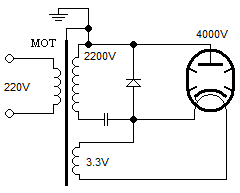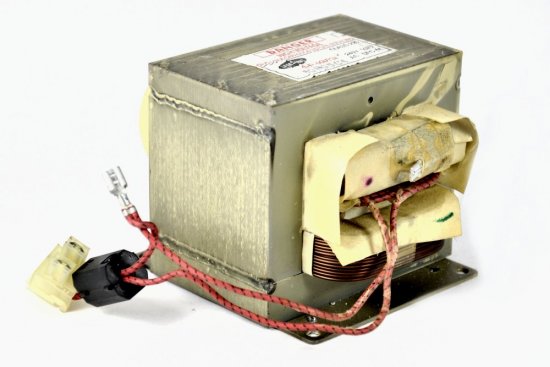ILO microwave transformer
To power the magnetron of the microwave oven, a rectified high voltage obtained from the network using a step-up transformer is traditionally used, which is called «MOT» (abbreviation from the English «Transforming microwave oven» — microwave oven transformer).
At the output of the ILO (or rather, at its anode coil), the alternating voltage in the region of 2200 volts is added to the voltage of the doubling capacitor (with a capacity of 1 microfarad) and is fed to the magnetron anode already in the form of a pulsating voltage with a frequency 50 Hz, on the order of 4000-4500 volts is sufficient for normal operation of the magnetron, which is a very powerful electronic device. The magnetron is here in parallel with the high voltage diode which serves as a valve in the voltage doubling circuit.

The magnetron is also heated by the MOT; for this purpose, there is an additional secondary winding (filament), consisting of 3 turns and giving from 2.5 to 4.6 volts at a current of up to 20 amperes.For each magnetron, the TO is selected individually, and therefore the parameters of the TO coils of different microwaves will differ slightly from model to model, up or down. One way or another, the MOT remains the heaviest element of any microwave oven, and it depends on how much power the magnetron can provide in a given microwave oven.
Many of those who had the opportunity to see the MOT or even were lucky enough to hold it in their hands, probably paid attention to the peculiarity that the dimensions of the MOT are very modest, despite the power of the microwave oven in which it was installed.
For example, if we proceed from the usual guidelines about the total power of the network transformer, it turns out that the MOT has 2 times less volume W-shaped magnetic circuitthan should be used with such a significant operating power of the microwave. This means that under its normal load, a transformer of this type operates in an unusual mode.
Let's see what makes the ILO different from other network transformers.
In fact, a microwave transformer does not operate all the time on a purely active load. An AC magnetron circuit is generally a capacitive load. For this reason, additional structural elements of the magnetic circuit — shunts — are installed between the windings of the microwave transformer.
Due to the presence of shunts, the working magnetic flux has the ability to be partially closed outside the secondary winding, which is equivalent to the inclusion of a ballast choke in the working circuit. For this reason, this particular MOT, with this particular magnetron paired with it, will work perfectly and will not fail.However, the ILO will continue to operate at the limit of its capabilities, albeit without falling into dangerous saturation. Statistics show that magnetrons fail most often, but not TO.
Reel lovers Nikola Tesla of the spark gap, ILOs are often used as high-voltage line transformers. To do this, several TOs are connected in series with anode windings, and the primary windings are connected in parallel. Often, to get more power from the MOT, teslast builders knock shunts out of the MOT and even dip transformers in oil.
Of course, even without shunts, the MOT is able to work even with a powerful active load, but such work will last no more than a few minutes, and severe overheating will not be late. Therefore, if the MOT is not used as intended, and even without shunts, it makes sense to use forced cooling.
Attention! The voltage on the secondary winding of the MOT is lethal and must be handled with extreme care.

